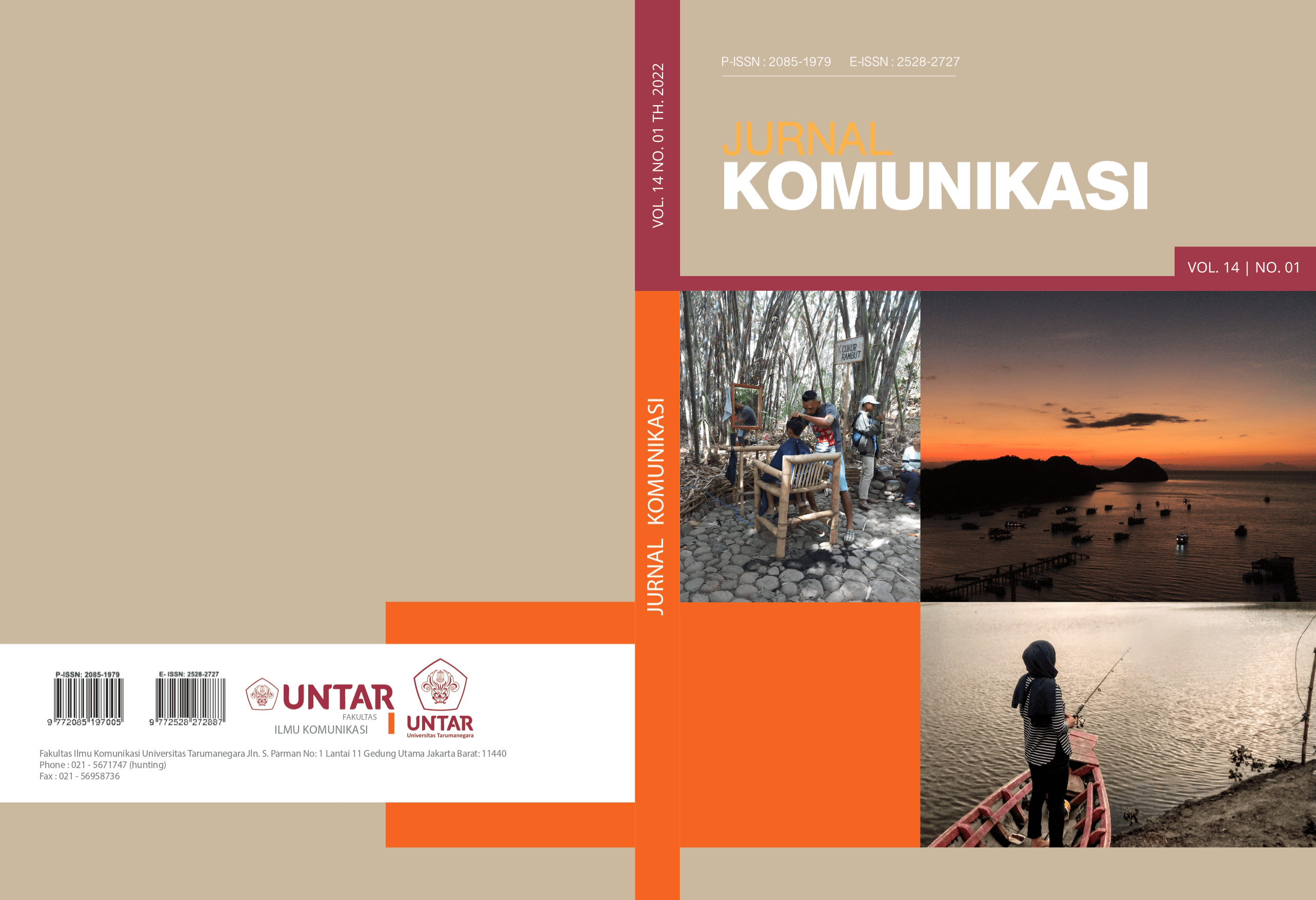Blind Eyes, Deaf Ears: Phenomenological Study on the Meaning of Local Figures of CSR of Semen Rembang
Main Article Content
Abstract
This research focuses on the problems surrounding mining conflicts and the synergistic CSR (corporate social responsibility) program owned by PT Semen Gresik at the Rembang Factory in Timbrangan Village, Kab. Rembang, which includes areas directly adjacent to the location of the factory or source of raw materials (Ring 1). The purpose of this study is to describe the experiences and meanings of local leaders (informal leaders, who are divided into pro and contra groups) regarding the CSR program that carries the narrative of welfare. This study uses a qualitative approach and a phenemenological method, in which the researcher allows community leaders who are the research subjects to actively construct meaning through their intersubjective experiences related to the Synergy CSR program. Data collection was carried out through in-depth interviews to obtain the essence of the phenomenon that was observed and told from a first-person perspective. This study found that CSR Synergy is interpreted by local leaders (informal leaders) as a program that tends to formulate the needs of the target community with the perspective of their own interests, tends to be compiled and implemented based on an assessment of citizens' needs. Research subjects also interpret CSR as a program that make targeted societies increasingly dependent on, not empowering, and merely fulfilling statutory obligations as a formality or to create a public image since the company is responsible for exploiting the natural resources. The welfare narrative brought by the CSR program was interpreted by the research subjects as a strategy to trick the public to cover up the impact of environmental damage. In the end, this meaning has the implication of the emergence of apathy, which is reflected in the local imagery of a short-sighted ear (blind ear, deaf eye).
Article Details

This work is licensed under a Creative Commons Attribution-ShareAlike 4.0 International License.
This work is licensed under a Jurnal Komunikasi Creative Commons Attribution-ShareAlike 4.0 International License.References
ABIDIN, Z. (2016). Paradoks Dan Sinjutas (Sinergi-Keberlanjutan-Ketuntasan) Gerakan Filantropi Di Indonesia. Share : Social Work Journal, 6(2), 183. https://doi.org/10.24198/share.v6i2.13201
Achda, B. T. (2006). The Sociological Context of Corporate Social Responsibility Development and Implementation in Indonesia. Corporate Social Responsibility and Environmental Management, 13(5), 300–305. https://doi.org/10.1002/csr.133
Achmad, S. . (2017). Asal-Usul & Sejarah Orang Jawa. Araska.
Atang, A. (2018). Gerakan Sosial dan Kebudayaan: Teori dan Strategi Perlawanan Masyarakat Adat Atas Serbuan Investasi Tambang. Intrans Publsihing.
Auty, R. M. (1993). Sustaining Development in Mineral Economies. Routledge.
Butterick, K. (2014). Pengantar public relations: teori dan praktik / Keith Butterick. RajaGrafindo Persada.
Creswell, J. W. (2007). Qualitative Inquiry and Research Design: Choosing Among Five Approaches, 2nd. Sage.
Crowther, D. (2008). Corporate Social Responsibility. Ventus Publishing ApS.
Darmastuti, R., Bajari, A., Martodirdjo, H. S., & Maryani, E. (2016). Gethok Tular, Pola Komunikasi Gerakan Sosial Berbasis Kearifan Lokal Masyarakat Samin di Sukolilo. Jurnal ASPIKOM, 3(1), 104. https://doi.org/10.24329/aspikom.v3i1.103
Effendy, O. U. (2009). Human Relation and Public relation. In Mandar Maju.
Hadi, N. (2011). Corporate Social Responsibility. Graha Ilmu.
Hidayatullah, Umar, Hartati, S.R., Thriwaty, A. (2016). Analisis Peta Konflik Pembangunan Pabrik PT. Semen Indonesia Di Kecamatan Gunem Kabupaten Rembang. Solidarity, 5(1), 1–11.
Hinson, R. E., & Ndhlovu, T. P. (2011). Conceptualising corporate social responsibility (CSR) and corporate social investment (CSI): The South African context. Social Responsibility Journal, 7(3), 332–346. https://doi.org/10.1108/17471111111154491
Kartikawangi, D. (2013). Tema Fantasi : Strategi Komunikasi Bisnis Perusahaan Multinasional. Gramedia Pustaka Utama.
Kuswarno, E. (2009). Metodologi Penelitian Komunikasi Fenomenologi: Konsepsi, Pedoman dan Contoh Penelitian. Widya Padjadjaran.
Laeis, Z. (2017). Embung Tegaldowo Rembang Bantu Atasi Kekeringan. https://jateng.antaranews.com/berita/175386/embung-tegaldowo-rembang-bantu-atasi-kekeringan
Lestariningsih, D., & Wariyatun. (2015). Nduweni Ibu Pertiwi (Keeping the Motherland): Women’s Agency to Resist Cement Plants in Tegaldowo and Timbrangan Villages, Rembang. Asian Journal of Women’s Studies, 21(2), 166–179. https://doi.org/10.1080/12259276.2015.1062271
Meglian, M., Yuli, N., & Djudy, D. (2016). Strategi Media Relations PT Semen Indonesia (Persero) Tbk Dalam Menjaga Citra Positif Pada Kasus Proyek Pembangunan Pabrik Semen di Rembang. 5(1), 70–92.
Moran, D. (2000). Introduction to Phenomenology. Routledge.
Prajarto, Y. A. N. (2012). CSR Indonesia: Sinergi pemerintah, perusahaan, dan publik. Fisipol UGM.
Purnama, F. Y. (2017). Semen vs Samin: the Impact of “Change.Org” Online Petition in Perspective of Laudato Si’. Philippiniana Sacra, 3(157), 803–814.
Qualitative Research Methods for the Social Sciences. (2017). In Teaching Sociology (Vol. 18, Issue 4).
Rahman, R. (2009). Corporate Social Responsibility: Antara Teori dan Kenyataan. PT Buku Kita.
Rajagukguk, S. B. T. (2016). Mengurai Perempuan dan Pembangunan (Studi Kasus Kartini Kendeng). Gema Keadilan, 3(1), 64–73. https://ejournal2.undip.ac.id/index.php/gk/article/view/3643/2030
Rosilawati, Y., & Mulawarman, K. (2019). Kearifan Lokal Tri Hita Karana Dalam Program Corporate Social Responsibility. Jurnal ASPIKOM, 3(6), 1215. https://doi.org/10.24329/aspikom.v3i6.426
Seidman, I. (2006). Review of Interviewing as Qualitative Research: A Guide for Researchers in Education and the Social Sciences. In Contemporary Psychology: A Journal of Reviews (Vol. 37, Issue 7). Columbia University. https://doi.org/10.1037/032390
Sukandarrumidi. (2012). Corporate Social Responsibility. Bajawa Press.
Sukoco, I. (2014). Fungsi Public relations Dalam Menjalankan Aktivitas Corporate Social Resposibility. Jurnal Dinamika Manajemen, 4(2), 188–198. https://doi.org/10.15294/jdm.v4i2.2762
Tim Invertigasi Tempo. (2015). Ditawari Duit Rp 1 Miliar Kepala Desa Ini Menolak. https://nasional.tempo.co/read/701861/ditawari-duit-rp-1-miliar-kepala-desa-ini-menolak
Wesfix, T. (2018). Public relations Itu “Dipraktekin.” Grasindo.
Wibowo, A., Zaini, R., Dwiningtyas, P., & Bekti, W. U. (2013). Pengembangan Masyarakat: Menelusuri Kearifan Lokal Masyarakat Samin di Pusaran Modernisasi Pertanian. Universitas Sebelas Maret.
Yunita, N. W. (2017). Cerita Warga Sekitar Pabrik Semen Rembang Tentang Demo Pro Kontra.



